
Concept explainers
(a)
Interpretation:
To identify the reagents needed to carry out the transformation
Concept introduction:
Reduction of an
Answer to Problem 12.43P
The reagents needed to carry out the transformation is H2/Pd-C to form the product

Explanation of Solution
Reduction of an alkene by the addition of H2 to one or both of the pi bonds. When an alkene is treated with two or more equivalents of H2 and using the Pd catalyst, reduction of both the pi bonds occurs. Syn addition of one equivalent of H2 to forms a cis alkane product. Thus one more addition of a equivalent of H2 to form an alkane. Four new C-H bonds are formed.

Reduction of the given transformation is carried out by using the Hydrogen (1 equ)/Pd-C reagent
(b)
Interpretation:
To identify the reagents needed to carry out the transformation
Concept introduction:
The given product is obtained by epoxidation, it is a stereospecific reaction because cis and trans alkenes yield different stereoisomers as products. A cis alkene gives an
Answer to Problem 12.43P
The reagents needed to carry out the transformation is mCPBA or metachloro perbenzoic acid to form the product

Explanation of Solution

Two C-O bonds are formed to one oxygen atom with one electron pair from the peroxyacid and one from the pi bond. Then the weak oxygen-oxygen bond is broken to form the epoxide product.

Reduction of the given transformation is carried out by using the mCPBA or metachloro perbenzoic acid reagent.
(c)
Interpretation:
To identify the reagents needed to carry out the transformation
Concept introduction:
The given product is dihydroxylation product. It is the addition of two hydroxy groups to a double bond, forming a 1, 2-
Answer to Problem 12.43P
The reagents needed to carry out the transformation is OsO4, NaHSO3+H2O or KMnO4+H2O to form the product
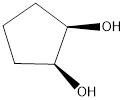
Explanation of Solution
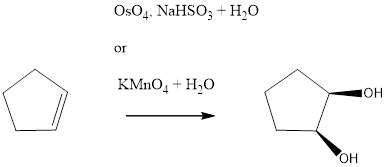
The reagent adds two oxygen atoms to the same side of the double bond in a syn fashion-to yield a cyclic intermediate. The cyclic intermediate is then to hydrolysis to cleaves the metalo oxygen bonds, forming the cis-1, 2-diol. With OsO4, sodium bisulfite (NaHSO3) is added for the hydrolysis to occur. In KMnO4 only H2O is used.
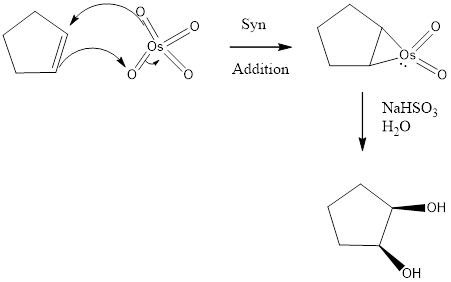
Reduction of the given transformation is carried out by using the OsO4, NaHSO3+H2O or KMnO4+H2O reagent.
(d)
Interpretation:
To identify the reagents needed to carry out the transformation
Concept introduction:
The given product is reduction product. Reduction of these C-X sigma bonds is an example of nucleophilic substitution, in which LiAlH4 serves as a source of a hydride nucleophile (H-). Because H- is a strong nucleophile, the reaction follows an SN2 mechanism.
Answer to Problem 12.43P
The reagents needed to carry out the transformation is LiALH4+H2O to form the product

Explanation of Solution

Because the reduction reaction follows an SN2 mechanism. The unhindered CH3X and 1 °

Reduction of the given transformation is carried out by using the LiALH4+H2O reagent.
(e)
Interpretation:
To identify the reagents needed to carry out the transformation
Concept introduction:
The given product is antihydroxylation product. Opening of the epoxy ring by OH anion and water to form the anti dihydroxylated product.
Answer to Problem 12.43P
The reagents needed to carry out the transformation is -OH+H2O to form the product

Explanation of Solution

Epoxidation of cyclo-pentene adds an O atom from either above or below the plane of the double bond to form a single achiral epoxide. Opening of the epoxide ring occurs by the backside attack at either C - O bond. Because the epoxide is above the plane of the five-membered ring, nucleophilic attack occurs from below plane.

Reduction of the given transformation is carried out by using the -OH+H2O reagent.
(f)
Interpretation:
To identify the reagents needed to carry out the transformation
Concept introduction:
The given product is antihydroxylation product. Opening of the epoxy ring by OH anion and water to form the anti dihydroxylated product.
Answer to Problem 12.43P
The reagents needed to carry out the transformation is PBr3 or HBr to form the product

Explanation of Solution

The bromo product is formed similar to SN2 fashion. Where bromo anion attack at the carbon where the alcohol attached so that bromo anion attack by the backside attack to for the bromo product.

Reduction of the given transformation is carried out by using the PBr3 or HBr reagent.
(g)
Interpretation:
To identify the reagents needed to carry out the transformation
Concept introduction:
CrO3/H2SO4+H2O is an oxidizing agent. Oxidizing agents. CrO3 are strong, nonselective oxidants used in aqueous acid H2SO4+H2O. The general mechanism is given below.
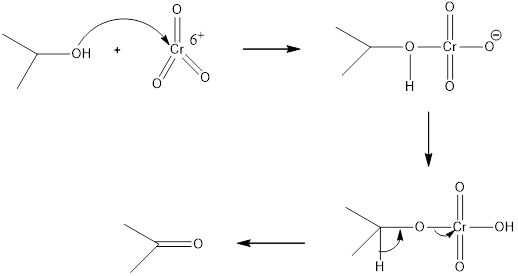
Answer to Problem 12.43P
The reagents needed to carry out the transformation is CrO3/H2SO4+H2O to form the product

Explanation of Solution

The oxidation of alcohols to carbonyl compounds is typically carried out by PCC or CrO3(where Cr6+ oxidants, which are reduced to Cr3+) to form the products. Oxidation of a 2 ° alcohol to an
Reduction of the given transformation is carried out by using the CrO3/H2SO4+H2O reagent.
(h)
Interpretation:
To identify the reagents needed to carry out the transformation
Concept introduction:
The given product is reduction product. Reduction of these C-X sigma bonds is an example of nucleophilic substitution, in which LiAlH4 serves as a source of a hydride nucleophile (H-). Because H- is a strong nucleophile, the reaction follows an SN2 mechanism
Answer to Problem 12.43P
The reagents needed to carry out the transformation is LiALH4+H2O to form the product

Explanation of Solution

Because the reduction reaction follows an SN2 mechanism. The unhindered CH3X and 1 ° alkyl halides are more easily reduced than more substituted 2° and 3° halides. In unsymmetrical epoxides, nucleophilic attack of H- (from LiAIH4) occurs at the less substituted carbon atom.
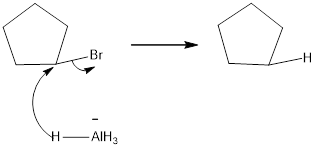
Reduction of the given transformation is carried out by using the LiALH4+H2O reagent.
Want to see more full solutions like this?
Chapter 12 Solutions
Organic Chemistry-Package(Custom)
- elow are experimentally determined van Deemter plots of column efficiency, H, vs. flow rate. H is a quantitative measurement of band broadening. The left plot is for a liquid chromatography application and the night is for gas chromatography. Compare and contrast these two plots in terms of the three band broadening mechanisms presented in this activity. How are they similar? How do they differ? Justify your answers.? 0.4 H (mm) 0.2 0.1- 0.3- 0 0.5 H (mm) 8.0 7.0 6.0 5.0 4.0- 3.0 T +++ 1.0 1.5 0 2.0 4.0 Flow Rate, u (cm/s) 6.0 8.0 Flow Rate, u (cm/s)arrow_forwardPredict the products of this organic reaction: + H ZH NaBH3CN H+ n. ? Click and drag to start drawing a structure. Xarrow_forwardWhat is the missing reactant R in this organic reaction? + R H3O+ + • Draw the structure of R in the drawing area below. • Be sure to use wedge and dash bonds if it's necessary to draw one particular enantiomer. Click and drag to start drawing a structure.arrow_forward
- What would be the best choices for the missing reagents 1 and 3 in this synthesis? 1 1. PPh3 2. n-BuLi 2 • Draw the missing reagents in the drawing area below. You can draw them in any arrangement you like. • Do not draw the missing reagent 2. If you draw 1 correctly, we'll know what it is. • Note: if one of your reagents needs to contain a halogen, use bromine. Click and drag to start drawing a structure.arrow_forwardThe product on the right-hand side of this reaction can be prepared from two organic reactants, under the conditions shown above and below the arrow. Draw 1 and 2 below, in any arrangement you like. 1+2 NaBH₂CN H+ N Click and drag to start drawing a structure. X $arrow_forwardExplain what is the maximum absorbance of in which caffeine absorbs?arrow_forward
- Explain reasons as to why the amount of caffeine extracted from both a singular extraction (5ml Mountain Dew) and a multiple extraction (2 x 5.0ml Mountain Dew) were severely high when compared to coca-cola?arrow_forwardProtecting Groups and Carbonyls 6) The synthesis generates allethrolone that exhibits high insect toxicity but low mammalian toxicity. They are used in pet shampoo, human lice shampoo, and industrial sprays for insects and mosquitos. Propose detailed mechanistic steps to generate the allethrolone label the different types of reagents (Grignard, acid/base protonation, acid/base deprotonation, reduction, oxidation, witting, aldol condensation, Robinson annulation, etc.) III + VI HS HS H+ CH,CH,Li III I II IV CI + P(Ph)3 V ༼ Hint: no strong base added VI S VII IX HO VIII -MgBr HgCl2,HgO HO. isomerization aqeuous solution H,SO, ༽༽༤༽༽ X MeOH Hint: enhances selectivity for reaction at the S X ☑arrow_forwardDraw the complete mechanism for the acid-catalyzed hydration of this alkene. esc 田 Explanation Check 1 888 Q A slock Add/Remove step Q F4 F5 F6 A བྲA F7 $ % 5 @ 4 2 3 & 6 87 Click and drag to start drawing a structure. © 2025 McGraw Hill LLC. All Rights Reserved. Terms of Use | Privacy Ce W E R T Y U S D LL G H IK DD 요 F8 F9 F10 F1 * ( 8 9 0 O P J K L Z X C V B N M H He commandarrow_forward
- Explanation Check F1 H₂O H₂ Pd 1) MCPBA 2) H3O+ 1) Hg(OAc)2, H₂O 2) NaBH4 OH CI OH OH OH hydration halohydrin formation addition halogenation hydrogenation inhalation hydrogenation hydration ☐ halohydrin formation addition halogenation formation chelation hydrogenation halohydrin formation substitution hydration halogenation addition Ohalohydrin formation subtraction halogenation addition hydrogenation hydration F2 80 F3 σ F4 F5 F6 1 ! 2 # 3 $ 4 % 05 Q W & Å © 2025 McGraw Hill LLC. All Rights Reserved. F7 F8 ( 6 7 8 9 LU E R T Y U A F9arrow_forwardShow the mechanism steps to obtain the lowerenergy intermediate: *see imagearrow_forwardSoap is made by the previous reaction *see image. The main difference between one soap and another soap isthe length (number of carbons) of the carboxylic acid. However, if a soap irritates your skin, they mostlikely used too much lye.Detergents have the same chemical structure as soaps except for the functional group. Detergentshave sulfate (R-SO4H) and phosphate (R-PO4H2) functional groups. Draw the above carboxylic acidcarbon chain but as the two variants of detergents. *see imagearrow_forward
 Organic Chemistry: A Guided InquiryChemistryISBN:9780618974122Author:Andrei StraumanisPublisher:Cengage Learning
Organic Chemistry: A Guided InquiryChemistryISBN:9780618974122Author:Andrei StraumanisPublisher:Cengage Learning
